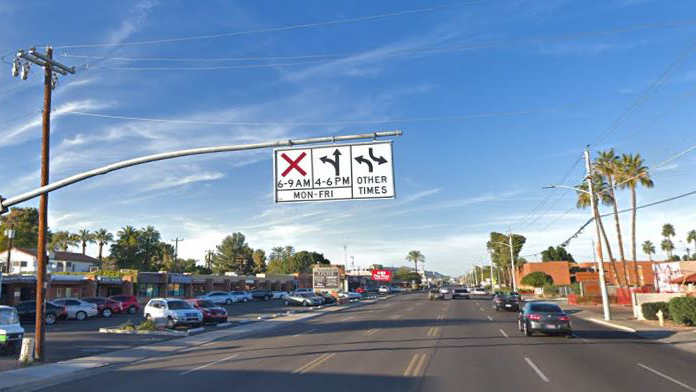
Defensive Driving Rule #57: Avoid “Reverse Traffic” Lanes
Some cities designate the center lane of major streets as “Reverse Traffic Lanes” to help manage traffic flow during rush hours. These lanes change direction depending on the time of day to accommodate the predominant direction of traffic. For example, in Phoenix, Arizona, 7th Avenue has a center two-way left-turn lane that converts to a southbound lane in the morning (6:00 a.m. to 9:00 a.m.) and a northbound lane in the afternoon (3:00 p.m. to 7:00 p.m.). While these lanes aim to alleviate congestion, they also introduce increased risks. Here are some important considerations and tips for safely navigating reverse traffic lanes:
Increased Risks of Reverse Traffic Lanes
- Close Proximity to Oncoming Traffic:
- Reverse traffic lanes often place vehicles uncomfortably close to oncoming traffic with no physical barrier between lanes. This proximity increases the risk of collisions, particularly side-swiping incidents.
- Timing Conflicts:
- These lanes are designated for specific times of use, but not everyone may adhere to the exact timing. For instance, if the reverse lane starts at 7:00 a.m., discrepancies in drivers’ clocks can lead to misunderstandings and unsafe maneuvers, such as illegal left turns.
- Driver Confusion:
- Despite signage, some drivers may remain unaware of the reverse lane rules or the current time, leading to dangerous situations when they mistakenly use the lane for left turns or other prohibited actions during reverse traffic periods.
Defensive Driving Tips for Reverse Traffic Lanes
- Avoid Using Reverse Traffic Lanes:
- If possible, avoid using reverse traffic lanes. Opt for regular lanes where traffic patterns are more predictable and less risky.
- Be Extra Vigilant:
- If you must use a reverse traffic lane, stay highly alert. Monitor oncoming traffic closely and be prepared for sudden, unexpected maneuvers by other drivers.
- Adhere to Timing Rules:
- Ensure you understand the exact times when the reverse traffic lanes are in operation. Check your watch or car clock to avoid using the lane outside of designated times.
- Watch for Signage:
- Pay close attention to overhead signs indicating the status of the reverse traffic lane. These signs typically show arrows or lights indicating whether the lane is open for your direction of travel.
- Plan Your Route:
- Consider planning your route to avoid streets with reverse traffic lanes during their active periods. Use alternative routes to ensure a safer, less stressful commute.
- Stay Out of Intersection Conflicts:
- Avoid making left turns from reverse traffic lanes unless it is clearly indicated as safe and legal. Misinterpreting the lane usage can lead to dangerous situations at intersections.
- Use Caution at Entry Points:
- Be cautious when entering a street with a reverse traffic lane. Check for any special lane markings or signs that indicate the lane’s current direction of use.
Conclusion
While reverse traffic lanes are designed to improve traffic flow, they come with increased risks due to their complexity and the potential for driver error. Practicing defensive driving, staying vigilant, and avoiding these lanes when possible can help you navigate safely. Until cities find a more universally safe and efficient solution, it’s best to remain cautious and aware of the unique challenges these lanes present.
